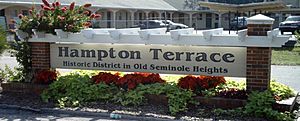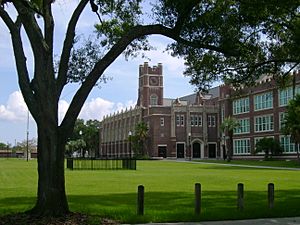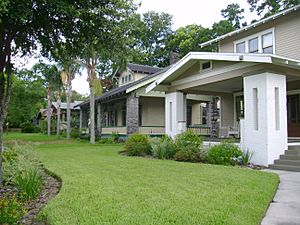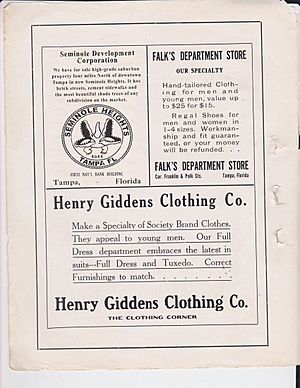Seminole Heights facts for kids
Quick facts for kids
Seminole Heights
|
|
|---|---|
| Country | United States |
| State | Florida |
| County | Hillsborough |
| City | Tampa |
| Founded | 1911 |
| Population
(2000 census)
|
|
| • Total | 24,567 |
| Time zone | UTC-5 (Eastern) |
| • Summer (DST) | UTC-4 (Eastern) |
Seminole Heights is a historic neighborhood and district in central Tampa. It's known for its many early 1900s bungalow homes and old buildings. This area was one of Tampa's first residential spots, connected by streetcar lines.
After a tough period in the late 1900s, Seminole Heights has become popular again. Many new restaurants and unique shops have opened. Its historic homes, cool stores, and delicious food spots are attracting more and more people. In 2000, about 24,567 people lived here.
Contents
Discovering Seminole Heights

Seminole Heights is famous for its historic bungalow homes, built in the early 1900s. Many buildings from that time are still standing. These include the Seminole Heights Methodist Church, Seminole Heights Elementary School, Broward Elementary, Hillsborough High School, and St. Paul's Lutheran Church.
The Seminole Heights Garden Center is a local park used for fun community events like art festivals and picnics. Seminole Heights also has the longest stretch of parkland along the Hillsborough River in Tampa. Parks like Rivercrest and Epps offer easy access to the river.
In recent years, homes in Seminole Heights have become more valuable, and the area has become safer. It's a popular choice for young professionals and families looking for a different kind of community. The area has two special historical districts: Seminole Heights itself (recognized locally and nationally) and Hampton Terrace (recognized nationally).
In 2003, Southeast Seminole Heights was even named "Best Neighborhood in America" by NUSA, a national neighborhood group. In 2009, This Old House Magazine listed Seminole Heights among the best places to buy an old house for many reasons, including for families and those who love porches or walking. It was one of the top eight picks by the magazine's editors.
This area has also become a great place to find unique restaurants. Some well-known spots include The Refinery, which has been nominated for a James Beard Award twice, the Independent Bar & Cafe', and Ella's Americana Folk Art Cafe.
The Two-Headed Alligator Mystery
In 2014, Seminole Heights made headlines around the world because of a "two-headed alligator." A local nature enthusiast sent a picture of it to a newspaper, which put it on its front page. People said local animal trappers caught it, and it was then preserved to be shown at Ella's Folkart Cafe.
However, many people wondered if the alligator was real. Some believed it was a creative artwork inspired by an old symbol. This symbol, a two-headed alligator, was used in early advertisements for the neighborhood. Since then, this creature has appeared in murals, on flags, T-shirts, and other items related to Seminole Heights.
In 2016, the two-headed alligator was in the news again. A community art project called Urban Art Attack helped fund the building of a two-headed alligator statue on Nebraska Avenue.
A Look at Seminole Heights History
Seminole Heights began in 1911. A man named T. Roy Young had 40 acres (about 160,000 square meters) of land. He wanted to create Tampa's first suburb, located three miles (about 5 kilometers) north of downtown. He named it Seminole Heights.
Ten years earlier, Tampa's population had grown to 26,000 people. A trolley line connected Sulphur Springs to downtown. This made it easy to travel to the suburbs, making them attractive places to live. People could now live in one part of town and work in another.
Young saw this opportunity. His Seminole Development Corporation's land was a rectangle bordered by Hillsborough Avenue, Central Avenue, Wilder Avenue, and Florida Avenue. The homes built here were mostly bungalows, facing east-to-west, and they started at $5,000.
Other housing developments quickly followed. By 1912, the Mutual Development Company and the Dekle Investment Company bought and planned land next to Seminole Heights. They created the Suwanee Heights subdivision. This area, bounded by Henry Avenue, Hillsborough Avenue, Central Avenue, and Florida Avenue, also had rules about how houses should be built. Like the original Seminole Heights, homes had to face east-to-west, but they started at a lower price of $1,400.
During Florida's "Boom" years (from about 1919 to 1929), more development happened in areas north and east of these first subdivisions. With more homes came more businesses. These businesses offered goods and services to the new residents. While some of those early businesses are gone, many current Seminole Heights businesses have been open for over 50 years!
Neighborhoods within Seminole Heights
The larger Seminole Heights area has a population of about 23,141 people living in 9,433 homes (as of 2009). The average household income was around $47,817. The average age of residents was 37. About 70% of the homes are owned by the people who live in them.
Seminole Heights is made up of three smaller, distinct neighborhoods:
- Old Seminole Heights (population: 15,062)
- South Seminole Heights (population: 3,160)
- Southeast Seminole Heights (population: 3,384)
Education in Seminole Heights
Here are some of the schools located within Seminole Heights:
- Hillsborough High School - Website
- Memorial Middle School
- Pepin Academies
Images for kids






